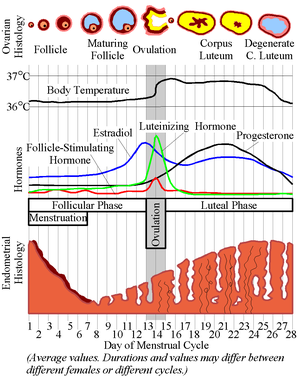Menstruation
Menstruation 101
Also referred to as a Period. The menstrual cycle is the monthly releasing of the uterus lining.
Stages of Menstruation:
1- The Follicular Phase
2- Ovulation
3- The Luteal Phase
Ovulation
Ovulation
When the follicle has matured, it secretes enough estradiol to trigger the acute release of luteinizing hormone (LH). In the average cycle this LH surge starts around cycle day 12 and may last 48 hours. The release of LH matures the egg and weakens the wall of the follicle in the ovary. It's random on which ovary it will come from, it can be left or right.
Luteal phase
The corpus luteum is the solid body formed in the ovaries after the egg has been released from the fallopian tube which continues to grow and divide for a while.This corpus luteum will produce progesterone in addition to estrogens for approximately the next 2 weeks. Progesterone plays a vital role in converting the proliferative endometrium into a secretory lining receptive for implantation and supportive of the early pregnancy. It raises the body temperature by one-half to one degree Fahrenheit. If fertilization of an egg has occurred, it will travel as an early blastocyst through the fallopian tube to the uterine cavity and implant itself 6 to 12 days after ovulation.
The Follicular Phase:
During the menstrual cycle, the sexually mature female body builds up the lining of the uterus with gradually increasing amounts of oestrogen. (Oestrogen Oestrogen is produced primarily by developing follicles in the ovaries)
Follicle stimulating hormone (FSH)(Follicle stimulating hormone (FSH) is a hormone synthesised and secreted by gonadotropes in the anterior pituitary gland.) and luteinizing hormone (LH) (Luteinizing hormone (LH) is a hormone synthesized and secreted by gonadotropes in the anterior lobe of the pituitary gland) stimulate the production of oestrogen in the ovaries.
